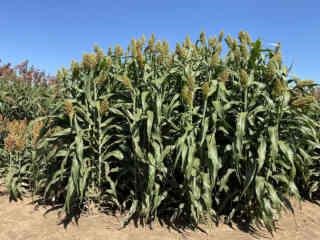By Kay Ledbetter
Producers in the Texas High Plains are reevaluating the forages they grow because of declining irrigation capacities and increasing forage demands from the region’s dairy herds.

The Texas A&M AgriLife forage sorghum trials at Bushland included 77 sorghum hybrids and three corn silage plots.
The Texas A&M AgriLife Research and Texas A&M AgriLife Extension Service annual Bushland Forage Sorghum Silage Trial provides producers a side-by-side comparison of sorghum hybrids. These represent forage sorghums, sorghum-sudan grasses and grain sorghum, along with corn grown in the same production environment. The 2022 trial compared 77 sorghum hybrids and three corn silage check plots.
“Producers are having to reevaluate forage options in light of declining irrigation capacities and persistent droughts,” said Jourdan Bell, Ph.D., AgriLife Extension agronomist in Amarillo, who leads the trial. “In a water-limited environment, sorghum is very efficient and will out-perform corn.”
The 2022 season was very challenging. At Bushland, the season started very hot and dry like throughout the Southern Great Plains, but fortunately, Bell said, timely localized rainstorms in July and August significantly benefited the trial plots.
“The 2022 trial average was 28.7 tons per acre, but it was amazing to see the maximum yielding forage sorghum reach 38.6 tons per acre. In comparison, a corn silage check yielded 35.9 tons per acre,” she said. “This year’s trial really helps producers see that sorghum hybrids are very competitive with corn.”
Water limits determine forage selection
While sorghum and corn hybrid yields were very high in the 2022 trial, it is important for producers to remember that corn yields will be reduced in a water-limited environment, Bell said.
“Sorghums, on the other hand, do not shut down as quickly under water stress,” she said. “And in water-stressed years, we see an even greater yield gap between sorghum and corn hybrids, with sorghum hybrids significantly outperforming corn.”
Bell said producers who have traditionally grown corn silage are now rethinking forage options, and that is why the Texas A&M AgriLife trial is so important.
“This trial provides an opportunity to compare new sorghum hybrids to corn, and for many sorghum hybrids, we can compare across multiple years,” she said. “This provides producers an opportunity to evaluate the hybrids’ stability.”
Bell said she wants producers to see that public and private sorghum breeding programs have invested significant effort to improving sorghums for ensiled forage.
“We hope our trial helps producers identify adapted sorghum hybrids that perform well in good and bad conditions to minimize their production risks,” she said.
Selecting forage options in 2023
Moving into 2023, many producers are facing forage shortages and the persistent drought will only magnify forage deficits due to supply shortages.
The Texas High Plains’ ongoing drought is seriously limiting regional forage supplies, Bell said. Producers are having to step back and determine what forages are available and weigh the different options to meet the end-user needs, whether those are for roughage or specific nutritional properties.
In her trials, Bell said sorghum grown for grain purpose is included as a grain check for the forages. The loan deficiency payment for forage sorghums is based on the grain yield potential of the forage in comparison to a standard sorghum check.
However, there is another reason she includes grain sorghum in the forage sorghum trial.
“We are also seeing that grain sorghums make a very good silage. So, depending on an end-user’s goal, having the grain sorghum in the trial also allows the producer to see how a grain sorghum might perform in comparison to a more traditional forage sorghum.”
Maturity class and water savings
Producers, in general, might assume that a later-maturing hybrid has a greater yield potential just because of the longer growing season, but that is not always the case, Bell said.
“We block and harvest hybrids by maturity so that each hybrid’s yield and nutritive value is compared at the same physiological stage,” she said. “Earlier maturing hybrids are very competitive, but producers should be aware yield can be magnified by grain yield. Later-maturing hybrids and photoperiod hybrids might not reach a soft-dough grain stage, so producers should consider the hybrid’s grain yield potential and their end-use goals when making hybrid selections.”
Maturity class should also be considered if water availability is a concern,” Bell said.
Earlier-maturing hybrids are growing for a shorter duration, so their total seasonal water use is going to be lower, she said. The water use during the key growth stage might not be lower, but the cumulative water use will be less.
“So, if a producer is sharing water with other crops or spreading water thin across greater acreage, sorghum will provide flexibility with regards to planting dates and partitioning of limited irrigation supplies,” Bell said.
Also, if someone is growing the sorghum for hay, they might prefer a hybrid that is not heading. As a hybrid transitions from vegetative to reproductive development, digestibility decreases. Male sterile hybrids are of interest for this reason, but it is important to remember that male sterile hybrids will be pollinated if there is a nearby pollen source. The male sterile hybrids in the Bushland trial are pollinated by neighboring sorghum hybrids.
Source : tamu.edu